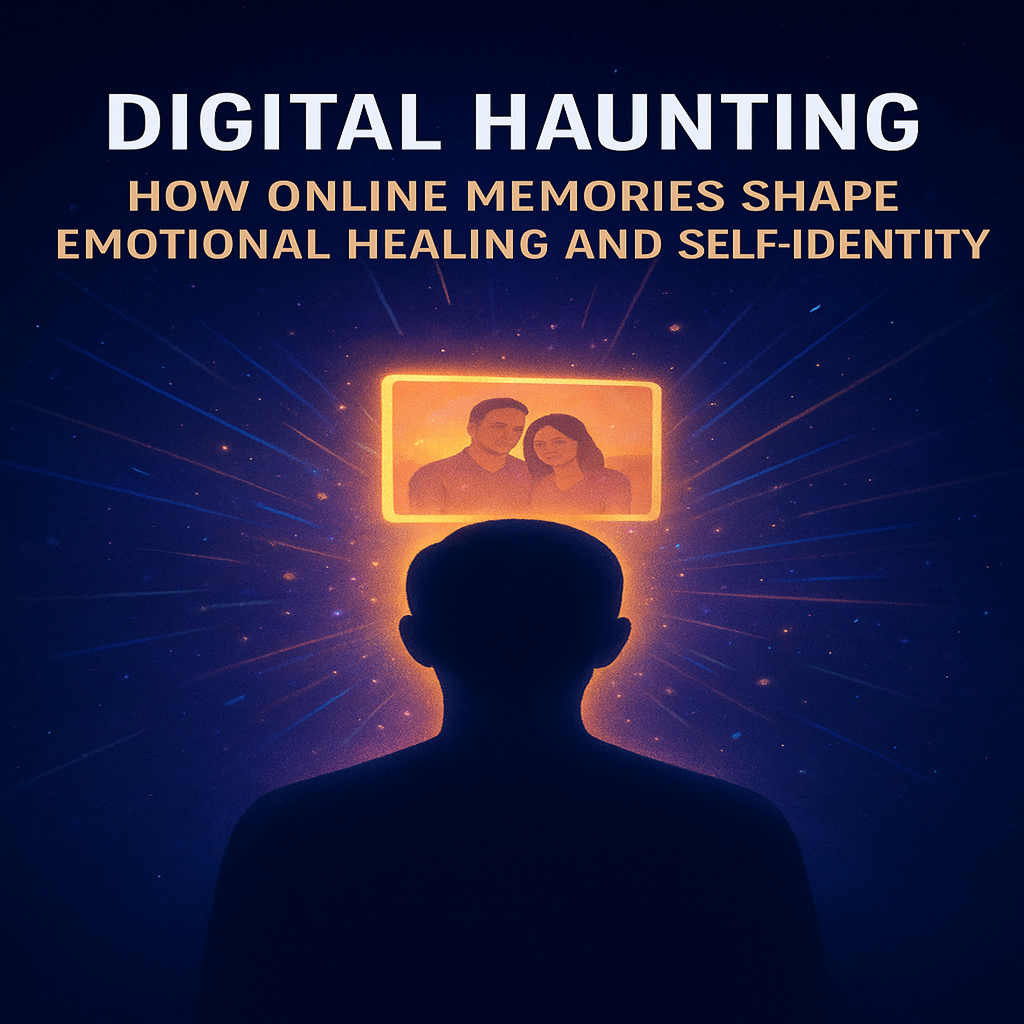
Digital Haunting: How Online Memories Shape Emotional Healing and Self-Identity
In today’s hyper-connected world, where life unfolds not just in reality but also across digital landscapes, our relationship with memories has changed profoundly. Traditionally, memories were preserved in journals, photographs, or simply stored in the mind, surfacing only when triggered by specific events. But now, the internet has become an eternal archive of our lives, filled with photographs, posts, conversations, and shared experiences that can resurface at any time.
This modern phenomenon has given rise to what psychologists and researchers informally call “digital haunting”—the persistent reappearance of online reminders that influence our emotions, relationships, and even our sense of identity. Whether it’s a Facebook “On This Day” memory showing a picture with a past partner, an old email resurfacing in your inbox, or a saved text message that pops up while scrolling, these reminders often carry emotional weight. Sometimes, they help us heal, but at other times, they reopen old wounds and disrupt our emotional progress.
In this article, we will explore the psychology of digital haunting, its impact on emotional healing, the shaping of self-view, and how individuals can consciously manage their digital footprints to align with their mental well-being.
What is Digital Haunting?
The phrase “digital haunting” refers to the feeling of being emotionally disturbed by digital artifacts of the past. These can include:
- Old photographs of friendships or relationships that ended.
- Social media memories that resurface automatically.
- Emails, voice messages, or saved chats that reappear unexpectedly.
- Tagged posts or content that reintroduce painful events.
Unlike traditional memory triggers—such as a song or a familiar place—digital reminders often feel intrusive because they appear without warning and are preserved in perfect clarity. A faded memory might soften over time, but a digital photo is frozen in its sharpness, as though the moment never truly ended. This can make moving on emotionally more challenging.
Learn more about Therapeutic Interventions and how can How to heal your past life trauma?
The Psychological Impact of Online Reminders
1. Reopening Old Wounds
When someone experiences a breakup, loss, or trauma, emotional healing usually depends on creating distance from the triggering memories. In digital spaces, however, these reminders are never fully gone. A picture of an ex-partner shared years ago might suddenly appear on a feed, reactivating grief or heartbreak. Psychologists refer to this as “emotional reactivation” when old feelings resurface as if they are happening in the present.
2. Distorted Self-Perception
Online reminders often shape how people view themselves. For example, someone might compare their present self with their “younger, happier” version captured in old photos. This comparison can lead to self-discrepancy a gap between the idealized self (the person we once were or wish to be) and the actual self. Over time, this can cause dissatisfaction and a distorted sense of identity.
3. Prolonged Attachment
Digital artifacts sometimes keep people emotionally tied to relationships or experiences long after they have ended. Seeing old messages or pictures can maintain a phantom bond, preventing emotional closure. This attachment may feel comforting but can hinder personal growth and the ability to move forward.
4. Collective Memory and Social Pressure
On social media, memories are not just personal—they are public. When old posts resurface, they remind not only the individual but also their social circle. Friends might comment or reshare, reinforcing the memory in a way that feels unavoidable. This adds an element of social haunting, where the digital past is re-lived collectively.
Digital Haunting vs. Healing
While digital haunting is often associated with negative emotions, it isn’t always harmful. For some, digital memories provide a sense of continuity, connection, and healing.
- Healing Through Reflection: Looking back on difficult times can help individuals measure their growth. For example, seeing an old post during a depressive episode might remind someone of how far they’ve come.
- Nostalgia and Comfort: Not all reminders are painful. Photos of loved ones, childhood events, or achievements can bring joy and warmth.
- Identity Reconstruction: Revisiting digital archives can help people understand their life story more clearly, aiding in self-awareness and identity formation.
The challenge lies in distinguishing between memories that support healing and those that trigger emotional distress.
Neuroscience of Digital Memories
From a neuroscience perspective, digital memories interact with the brain differently than traditional memories.
- Vivid Encoding: Photos and videos are stored with high visual and emotional intensity, making them harder to fade.
- Repetition Effect: Each time a digital memory resurfaces, the neural pathway associated with that event is reactivated, strengthening its presence in the brain.
- Emotional Looping: Unlike natural memory, which blurs with time, digital reminders keep emotions “fresh,” preventing the natural fading process called memory reconsolidation.
This neurological reinforcement explains why digital haunting can feel more overwhelming than traditional memory triggers.
The Role of Technology in Emotional Healing
Tech platforms play a critical role in shaping how memories are resurfaced. Features like “On This Day” on Facebook, Instagram archives, or Google Photos slideshows are designed for nostalgia but often fail to consider the psychological risks.
Some platforms have introduced features allowing users to filter memories—for instance, muting certain people, dates, or events. Yet many people are unaware of these tools or find them emotionally difficult to use, as deleting digital traces can feel like erasing a part of their identity.
Coping with Digital Haunting
Healing in the digital age requires bothpsychological resilience and digital awareness. Here are some strategies:
1. Curating Digital Footprints
- Regularly review and clean up digital content.
- Archive or delete memories that feel emotionally heavy.
2. Mindful Engagement
- Practice mindfulness when reminders appear.
- Instead of suppressing emotions, acknowledge them and reflect on why they are painful.
3. Digital Detox Periods
- Limit time on platforms that constantly resurface old memories.
- Use apps that promote healthier digital engagement.
4. Reframing Memories
- Use reminders as opportunities for growth. For instance, instead of focusing on the pain of a past breakup, one can reflect on what the experience taught them.
5. Professional Help
- For individuals deeply affected by traumatic digital reminders, therapy—especially trauma-informed therapy—can help process unresolved emotions.
Digital Haunting and Self-Identity
One of the most profound effects of digital haunting is how it shapes self-identity. Our online archives become a mirror of the self,
This leads to important questions:
- Are we the same person as our digital past portrays?
- Do online memories trap us in old identities, or do they serve as steppingstones for growth?
In this way, digital haunting is not just about emotions but also about existential understanding—how we define who we are in the continuum of time.
Future of Digital Memories: AI and Beyond
As artificial intelligence becomes integrated into digital platforms, the experience of digital haunting will likely evolve. AI can predict which memories to show, potentially tailoring experiences to either comfort or provoke.
Imagine an AI system that recognizes your mood and chooses whether to show you a certain memory. Alternatively, future platforms might create virtual simulations of the past, where individuals can re-experience moments with incredible realism.
While this might provide healing opportunities, it also raises ethical and psychological questions: Will people become stuck in virtual memories? Will AI intensify haunting by making memories more vivid than ever before?
Conclusion:
Digital haunting is one of the most unique psychological challenges of the modern age. Our memories, once fluid and subject to natural fading, are now preserved indefinitely in digital archives, resurfacing at moments we cannot always control. These online reminders hold power over our emotions, healing, and identity.
While they can trigger pain, they also offer opportunities for growth, reflection, and continuity. The key lies in conscious engagement—choosing how we interact with our digital past and ensuring technology serves our emotional well-being rather than disrupting it.
In the end, digital haunting forces us to confront a profound truth: our relationship with memory is no longer just biological—it is technological. And in navigating this new terrain, we are learning to redefine what it means to heal, to remember, and to be ourselves in a world where the past is only a click away.

